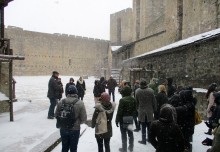Development and Application of Scientific Methods in Design and Construction of Economical Structural Systems Using New Technologies
TR 36008, Ministry of Education, Science and Technological Development RS, 2011-2014
Integrated structural design provides the quality during life cycle, which is one of the main recommendations for sustainable construction, and hence the significance of this Project is in promoting specific design approach which has not been sufficiently represented in our practice. Considering the fact that some composite materials are qualified as environmentally acceptable, but possible forms of their application in architectural structures have not been sufficiently explored from the point of view of practice and theoretical knowledge, the research is focused on expanding the range of possible solutions with the use of these types of materials, with particular emphasis on the use of ferrocement.
The research deals with the development and application of scientific methods in design and construction of highly-economical structural systems using new technologies. The subject is integrated structural design in architecture and application of new technologies in construction of architectural buildings. The approach to design of load bearing structures has significantly changed and a new philosophy has been developed called PBDC – Performance Based Design Concept. This principle is opposed to the traditional approach, namely it is based on the conversion of construction and structural requirements into properties, such as reliability, durability, renewability, safety during life cycle, etc. Also, the design approach to bearing materials is changed – PDDA – Performance Driven Design Approach, where materials are designed as per needs of individual applications. Structures are designed so as to fully use specific properties of applied materials. Design of load bearing structures is an intensive combination of architectural and engineering activities.
This project is being implemented in partnership with the Faculty of Civil Engineering, University of Belgrade; Faculty of Forestry, University of Belgrade, and with the participation of Milinkovic Company/
University of Belgrade – Faculty of Architecture, Project Leader: dr Miodrag Nestorović






